The billboards along the A1 north of Lisbon.
And in the crowded arrival hall in the Madrid airport, while we’re queued for passport control, the sole video screen is showing motorcycle racing. Okay!
The billboards along the A1 north of Lisbon.
And in the crowded arrival hall in the Madrid airport, while we’re queued for passport control, the sole video screen is showing motorcycle racing. Okay!
Ever been in a project where, in order to do A, you must first do B; and to do B, you have to get C working; and to get C working, well: you need a lathe.
I have a lathe, classic American model, gift from a friend. Its status at my house for some years has been, “needs assembled”. And, since its original power source was a foot treadle, it also needed some fabrication and wiring to fit an electric motor as the power source. The required materiel was in the same set of boxes that held the main body of the lathe, and similarly, “needed asssembly”.
It happens that the motor expects three-phase 208V, which would have ruled it out at my house (which has only single-phase 240V), save that another box held a “variable frequency drive / inverter”.
After a lot of learning, I got this today:
After 2018’s Red Hat triumph, we laid off for a year to see how our feelings vis-a-vis Bonneville racing developed. Would we be sated by that odyssey? Would we be anxious to return? Would the team take up iron-butt motorcycling instead?
Turns out that Salt Fever is not so easily cured. The team chatter about ‘trying to raise the Blown Gas Coupe record‘ started near the end of 2019. Here’s what we were thinking: this car ran 200+ on its last four outings, and nothing the motor said or did suggested that it’d been hurt by those record passes; if we just changed out some bodywork, Pickle would fit into another class, with a record just over 175mph. Shouldn’t it be easy to crank that up?Isn’t its mere existence at that level, in fact, a demand that it be raised?
In early 2020, a critical mass of interest formed, and work started. Pickle’d been resting in the Car Palace since it was cleaned up on our return in 2018, but now it was pulled out of hibernation and went on the lift. There was a bit of corrosion on the underbelly… then we found the frozen brake calipers… then found the immobile suspension… then noticed the funny way the turbo spun. Hmm. It doesn’t like sitting around, does it?
Another major challenge was that the engine control unit (ECU) and its complete harness had been removed. These components had been lent to Pickle for the 2018 meet, and were returned to the owners after. We got a duplicate ECU and harness, but figuring out where all the connectors and power leads went consumed several days. And one ECU output, for the tachometer, stubbornly refused to talk to the dash-mounted instrument, or at least it didn’t move the needle. We thought we’d keep trying when we had time…
Boom! It was August, and Speed Week was here. We packed a bunch of tools and the whole team, and went to the salt.
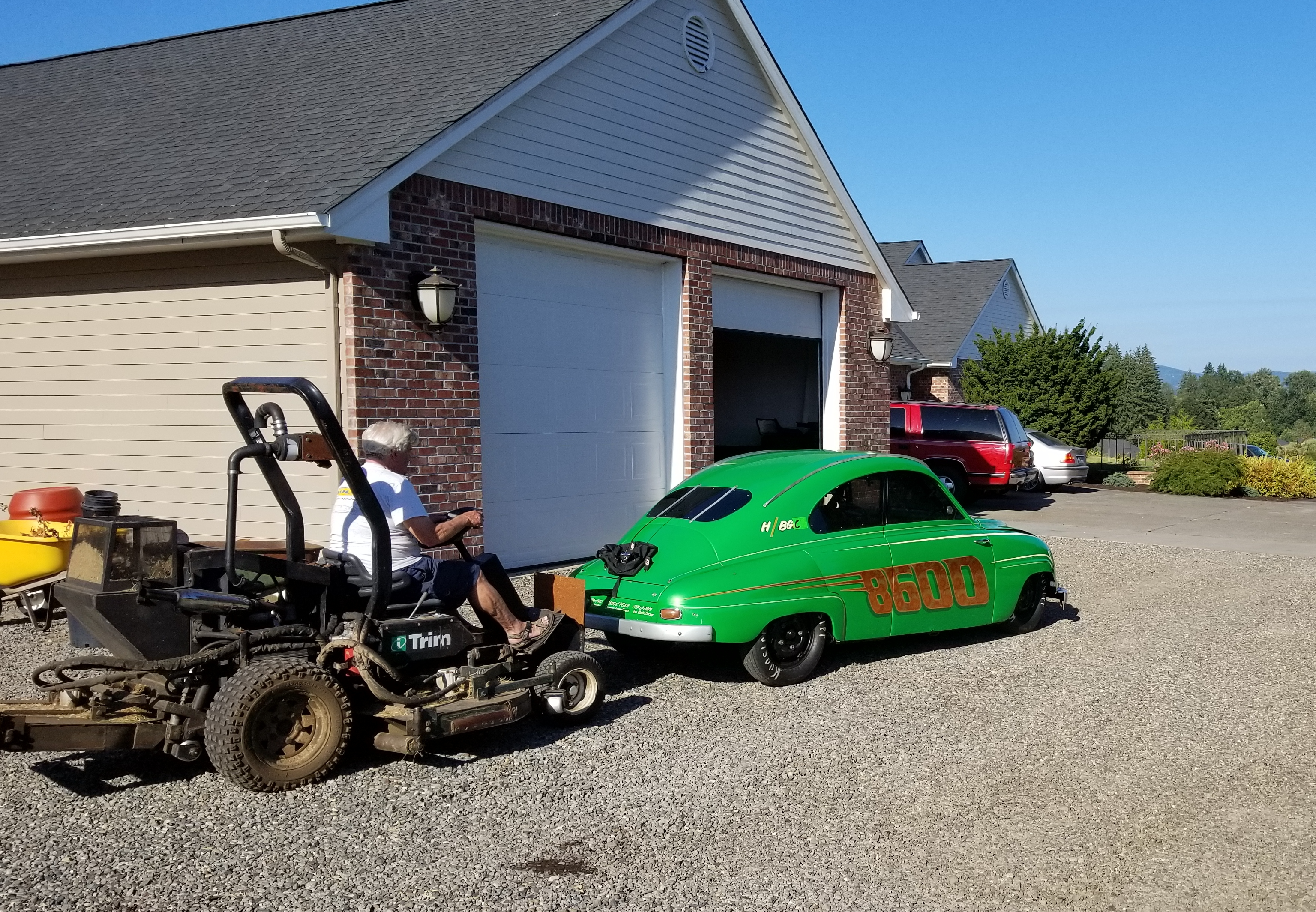
Car #8600, the Flying Pickle, arrived Saturday morning and we set up pits east of Tech Inspection. Covid has changed the workflow on the salt, and the TechInspector (1) now comes to your pit as opposed to the car going to Tech Inspection. Formerly, there were three or four inspectors focused on each car as it came through, but now (having to account for travel out to various pits), there’s only one inspector.
We made a run on Saturday afternoon, but it was quite slow – around 165mph. That was a bit puzzling because this same motor/car combination ran over 200mph on its last outing. We turned to our old friend, ‘data’, to look for clues for the slowness… but found that both data collection systems had had problems on that Saturday run. The cause of those faults? Corrosion in electrical connectors. What they did tell us was that the driver was shifting early, and he admitted as much: “Without a tach, it is really hard to tell how high you’re spinning it. You have to realize how violent the experience is when the motor hits its sweet spot.” Hmmm… guess we better make the tach work.
Sunday we’d corrected the tach issue, and fixed the data collection problems, but we still weren’t reaching speeds we expected. Pickle went around 177mph. The data said that turbo boost fell off after the shift to fifth gear, and the car barely gained speed thereafter. It looked to us like the rpms in fifth gear were just slightly below the level where the turbocharger ‘takes over’, pushing more and more air into the engine and then feeding off the exhaust from that bigger meal. Turbochargers are self-reinforcing in that way, and require pressure relief valves in the exhaust plumbing to reduce the feedback effect. Otherwise the cycle continues ‘until a mechanical limit is reached’.
Sunday’s speed was still enough to qualify for a record attempt (barely), so the car went to the impound area for a designated work period and a ‘record run’ the following morning. While we were prepping systems in Impound, though, a gaggle of Tech Inspectors came over and told us the roof rails on the car were out of specification, and disqualified our run. I suspect that the issue would have been caught had the normal Tech Inspection routine been in place.
We towed Pickle out of impound, and removed the errant roof rails in our pits. Monday morning we made a small adjustment to the fueling in the rpm band corresponding to the rpm after a gear shift, and had the driver hold fourth gear to 10,200 rpm — hoping to land high enough in fifth gear to let the turbo pull it up into the powerband.
Our speed of 176mph again qualified us for a record attempt the next morning, so we were back in impound Monday afternoon, racking our brains to figure out why we weren’t going faster. We’d also noticed that Pickle was becoming very hard to start. It would crank without firing, pop a little, then crank again. We tried various combinations of throttle opening, fuel pump on/off, … crossing our fingers … but the hard starting coupled with the lack of speed had us doubting our assumptions.
Tuesday we were at the end of the road at 6am, along with other teams whose vehicles would be making record attempts. The officials led us out to the Impound area for a brief work period, and TeamPickle had a little extra time before we had to go to the starting line. We thought we’d start the engine to warm it up (and to reduce our anxiety about it not starting at all).
Our working theory Tuesday morning was that ‘cranking speed’ (the crankshaft rotational speed that the starter motor imparts) was low, and that was the cause of the hard starting. Pickle carries a large 12V battery on-board for running pumps, and this is also used for the starter motor. To augment that, we clamped on a battery charger, and connected our push truck’s umbilical cord. We had amps and volts a’plenty.
Press the button! whirr whirr whirr pop whirr whirr whirr whirr pop whirr whirr whirr whirr… (repeats)
Now our anxiety was back twofold. What is causing this?! The deadline to leave Impound was imminent. With nothing to lose, we decided to try bump-starting Pickle during the tow to the starting line. Hey – it works on motorcycles… sometimes.
And it worked for us: the engine fired very quickly, and we let it run during the tow to the start line. (We noticed on Thursday a.m. that other teams do similar bump starts… but I’m getting ahead of myself.)
The record we were chasing was 176.393 m.p.h. Our speed on the qualifying run would be averaged with our speed on the ‘record’ run. Our qualifying speed was over the record by just a little bit, so we could set a new record if Pickle could manage 175.267 m.p.h. plus. Pah – this car can go over 200 m.p.h. Should be easy.
We didn’t make it. The top speed was 174-ish. We towed back to the pits, out of ideas and frustrated.
Luckily, we had fresh eyes in the pits, a visiting couple that we know from rally racing in the Pacific Northwest. Steve is a professional mechanic, and he was able to re-set our tangled brains into verifying the basics of internal combustion:
The compression gauge came out, and we checked all four cylinders. They read:
90# – 30# – 30# – 50#
Well, there’s your problem, Bob. This engine normally has approximately 160# across the board. That could explain the hard starting. But it also seemed really low… with those kind of numbers, how (we asked ourselves) is the car going 175m.p.h.? We kind of shrugged and pointed at the enormous turbocharger. Perhaps with enough boost, static compression matters less? This was blowing our minds, but the facts where there, right in front of us.
We went looking for the cause of the low compression. A shot of oil into the cylinders (to help the piston rings seal) didn’t change the numbers. We thought it likely we’d burned the edges off the exhaust valves, and we were losing seal there. A check of valve clearances on the exhaust, though, showed all eight in spec. The mystery deepens. Almost on a whim, we checked the valve clearances on the intake side, and then checked them again; because seven of eight were showing zero clearance. That would cause the valves to be slightly open in their ‘resting position’, and that would certainly reduce compression.
Did we bring the shims needed to set the clearance on the intake valves? No-sir-ree, we had not. That is why, if you were on Interstate 80 between Bonneville and Salt Lake City on Tuesday lunchtime, you’d have seen me around max legal speed heading to an open motorcycle shop for a shim kit.
I won’t describe in detail the hours and hours of work it required to get clearance on those intake valves, but we next made a run on Wednesday, in the late afternoon. Result: 177 m.p.h., qualifying speed, and we were back in Impound for the third time.
None of us had then an explanation for why the intake valve clearance disappeared, nor have we come up with one since. But there were other strange things happening with and strange noises emitting from the engine, and together they’re like a big red flag waving: You’ve been asking me to put out 3x normal power for many runs now, and I am… getting… tired.
We figured our chances of succeeding in our record run Thursday morning were less than 50-50 (the greater odds were on the combination of ‘running too slow’ and ‘blowing up violently’.)
So naturally… we turned up the boost.
Well, the motor will need a complete rebuild anyway; at least we’ll have a chance at setting a record. This was our rationale. And, before now, we’d always been afraid to touch the boost knob, which was still at the setting chosen by the engine tuners. So we felt both compelled and naughty when we twisted it a full turn.
At the starting line the next morning, we were part of a Spectrum Of Speed; the other lane held a 60cc moped which hoped to make 48 mph. Then the Pickle, hoping for 190 mph. And next to us, the recent king of wheel driven land speed, the Speed Demon streamliner run by Poteet & Main, which was shooting for 480 m.p.h.
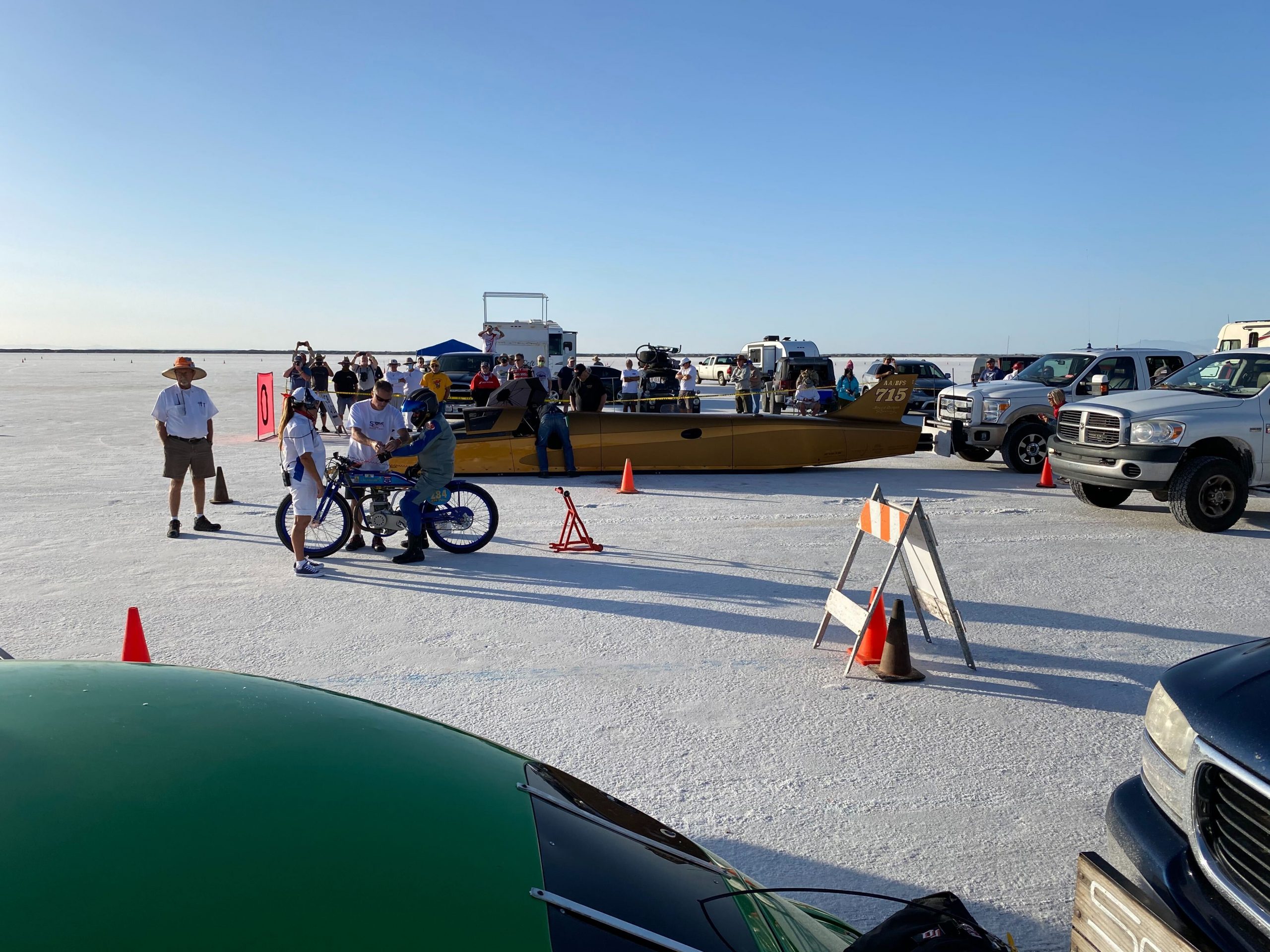
All three of us set records.
We’d completely exhausted ourselves during the week, and managed to raise the record in 1500cc Blown Gas Coupe by a measly 3mph. But it is the current record.
See Run Data Here
This is the GPS signal from the databox. We collect data more frequently now, so I had to ‘expand’ the 2018 trace to fit the timescale. We should try to use the same settings to make lining things up easier. 🙂
Note that the Nano seems to have died partway through the final run… all I had were zeros after that. You see the purple line just stop in the middle of its plateau. Also! You can see the lower gearing working, at least ’til the engine runs out of power.
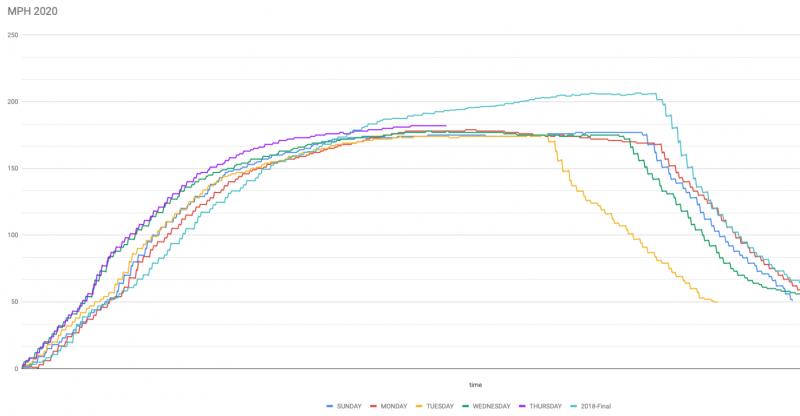
These are absolute manifold pressure values. They come from the databox, which is using a different style of MAP sensor than the ECU does. We should use the same damn sensor. 🙂 Can you tell which line is 2018?
Our cranked-up boost knob on Thursday (green line) was looking good at the beginning. We also lost that signal from the databox when the Nano stopped. You can see the ECU’s MAP numbers in the next graph, though. Not pretty.

We changed the RPM at which logging starts, so the 2020 run starts ‘earlier’. We should try to use the same settings to make lining things up easier. 🙂
The two top lines are MAP, the two bottom lines are RPM. You can see the shift points in the MAP values of the 2018 line, but the 2020 MAP line is just … blah.


Unpacked! Tech’d! Ran! but rpms were low, for good reason.
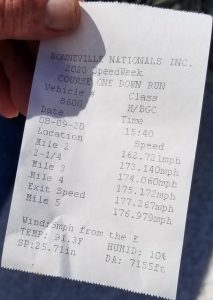 Tach fixed, qualified! in two miles, #4 and #5. Went straight to Impound.
Tach fixed, qualified! in two miles, #4 and #5. Went straight to Impound.
Speed seemed low, though. And the roof rails seemed high, according to the TechInspectors. The rails disqualified our run, and we went back to the pits for thinkin’.
The data showed a tiny speed trend upward throughout.
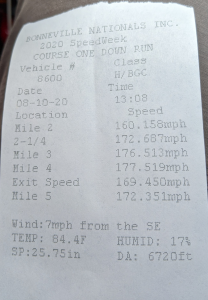 Qualified again, this time without roof rails.
Qualified again, this time without roof rails.
Review of the data showed some good boost in the lower gears, but nuthin’ much happening in fourth or fifth gear. Spent some time talking about rev limits and shift points, and made a small tweak to the fueling around 8,800 rpm to try to help the engine get on the pipe.
A disturbing pattern emerged; mile four was only slightly faster than 3, and mile five was slower than 4.
We were in Impound from Monday’s run. We tried to start the engine to warm it up before towing out, but barely got a ‘pop’. In desperation, we decided to bump-start the car during the tow.
That worked, thank goodness. We were far back in the line at the start, as we’d delayed getting out of impound. With the engine running since the tow, the water temp was getting a bit high. We shut off the engine, figuring that we could bump-start it again at the line if necessary. But, warm now, the engine restarted when it needed to.
The run only went through Mile 4 ’cause that was the mile in which we qualified Monday. However, it was too slow to set a record.
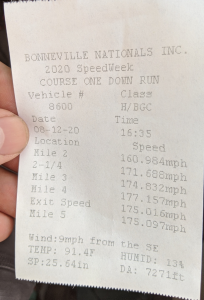 After six or so attempts to get the intake valve clearances set, we had reasonable compression in the motor. Everything else was ready, and mile #4 qualified!
After six or so attempts to get the intake valve clearances set, we had reasonable compression in the motor. Everything else was ready, and mile #4 qualified!
The overall pattern, though, was the same as the previous days; speed peaked in mile four, then slowed down thereafter. Checked the compression in Impound, and it was about the same as before the run. Where is the speed?
Found water on the floor of the cabin, and identified a crack in the coolant water tank behind the driver. N.B. epoxy sets up quick when the outside temp is near 100F.
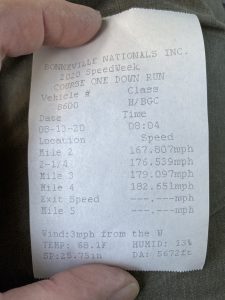
We were in Impound from Wednesday’s run. The water tank patch held overnight. Just before we towed out, Tom gave the Boost Control knob one full twist in the ‘+’ direction. Later the ECU data from the MAP said boost was approximately 4psi higher than it had been.
We didn’t have to bump-start the car (though we feared we would).
The gear ‘slip/catch’ which had been present in 2nd gear now appeared in 1st gear as well. The car had good speed at the 2 1/4 mark, but struggled so much that the driver felt it hadn’t made the record; he was surprised to hear it worked.
The run only went through Mile 4 ’cause that was the mile in which we qualified Wednesday. Record set!
All moments of life are colored by our emotions. None of us, in sensing – in seeing – is a neutral slate upon which experience is writ. We bring to every event a pre-setting, a state of ourselves; and what we feel in the offing is the combination of that state and the actual sensations of the event. This is what makes the anticipated kiss sweeter, the apprehended danger the more frightening, and the overdue respite more satisfying.
The Flying Pickle, Bonneville Speed Week 2018
Since Pickle first started trying to run 200 miles an hour, five years have passed. Most recently, in 2017, with a fresh motor and a ‘hot’ tune, we spent a day and a half driving to the Bonneville Salt Flats, only to find that the car’s ECU settings weren’t suited for the conditions, and the car made no more than 142 miles per hour. Our drive home was full of self-recrimination and regret.
This year we had a detailed plan. The tuning issue had been addressed with a session on the chassis dynometer. For everything else, we organized a series of work days, one a month, from March through July. We added sensors, produced logistical aids like towbars and a detachable muffler, and tried to validate that the car’s mechanical components were ready for 200 miles an hour. But it’s almost impossible to ‘test’ a land speed car… one needs many miles of road, with wide-open throttle, to reveal the real issues.
By the final work day, we were running short on things to do. We began talking about “What extra body parts should we bring to run in a second competition class after we break the record we’re targeting?” Oh, we were confident.
Since we were ahead of schedule, we left one day early, to reach the salt on Sunday, the second day of SpeedWeek. We wouldn’t be able to run Sunday, but we expected to do so on Monday. My imagination had us qualifying for the 200 mph record Monday afternoon, making the record run early the following morning, and thus being able to attend the RedHat (200mph Club) banquet scheduled for Wednesday night. I brought a suitcase full of dress shirts, because I thought we’d have time to kill between what promised to be one fantastic run after another.
Monday
No problems on the 11 hour drive from Battleground yesterday. We set up our pit and went over to register. Quite a few folks down there know the Pickle, and the registrar arranged to give us a cheaper pre-paid entry from a team that didn’t make it. A crew of safety inspectors checked the car over, and gave it thumbs up. We headed to the starting line.
Unlike 2017, when we queued at least four hours for each run, this time we waited perhaps half an hour. We barely had time to warm the motor up. We pushed Pickle off the line, and at around 50 miles an hour the car pulled away… not running completely cleanly, but obviously better than 2017. But as the push truck raced down course on the Return Road, the radio told us that the Pickle was already pulled over, barely past Mile Two.
We reached the car quickly. The driver told us there’d been a terrible noise from under the hood, and then the motor revved freely, with no drive to the wheels. He thought the car had thrown its chain. This felt distressingly familiar.
The chain drive system on the car is its Achilles’ heel; but what do you expect when you’re putting three times the normal power through it? One task on an early work day was ‘check the the chain drive system’, but at that time, all looked well. We saw no need for disturbing it, and besides, we didn’t see any obvious design improvements to make. The chain drive was one of the few systems that we didn’t fortify before we went to Bonneville; now that neglect came home to roost.
In the pits, we raised and supported the car, and removed the belly pan. Bits of broken chain were lying on the topside of the pan. Worse than that, we could see that the main sprocket, the one attached to the axle, was badly damaged. We set about removing the axle and sprocket for closer inspection. It is a tricky and annoying job, even in a shop, where you have a full toolbox and the car overhead on the lift. Now we were forced to do it lying flat on our backs, with limited maneuverability for tools and limited space for mechanics.
By 4 o’clock, we had the axle out. Then we saw the full extent of the damage.
We think the axle moved forward on one side in response to the pull of the motor. The chain then walked up the side of the sprocket, and as there’s very little slack in the system, the chain got real tight. The master link sheared off both pins in the end plate before failing completely. Then it was mostly a metal blender down there. Several teeth on the main sprocket were missing, or fractured. The chain was torn to pieces. The steel chain guard was mangled. Luckily, the engine sprocket was only lightly marred, and miraculously the engine cases showed no damage at all. (dang, that’s lucky. -ed)
There was no chance of continuing with that sprocket. And – we brought no spare, as working on the axle system was deemed ‘too difficult’ for the salt: why provision for actions that you cannot imagine taking? But now we had no choice but to work on it. If we couldn’t repair the chain drive system –and find a way to ensure that the axle would stay put under maximum power – we might as well go home; and nobody wanted to make another drive like 2017’s.
On the side of the sprocket was a manufacturer’s mark; not a part number, just a brand. An Internet search revealed that their factory was in Utah, somewhat south of Salt Lake City. (dang, that’s lucky. -ed) We found their phone number and called. Explaining our situation, we asked if they had a record of the sprocket, but they did not. The owner suggested that we measure our sprocket, pass those measurements to him, and they would do whatever it took to build a sprocket, and get it to us by mail by Wednesday.
But we were suddenly very conscious of time. Kicked off the salt at 8 PM, we returned to our casino/hotel and worked on a more expedient plan.
Tuesday
We dispatched two members of our team, at 4 AM, to drive to Richfield, Utah, and be at the sprocket-makers‘ shop when they opened. The rest of us headed out to start repairs and work on a more secure mounting system for the axle to resist the 400 hp of the motor.
By Tuesday midday the remote team had returned with a replacement sprocket. The rest of the day, we worked painstakingly to install the axle shaft, chain, and our one spare crush-fit master link for the chain. Conditions were ‘normal’ on the Salt in August, which is to say abnormal for most every other place on Earth. Blinding sun, a dearth of humidity, an occasional breeze bringing only parched air.
Under the car, we rotated shifts of workers. It went on all day. We left the salt Tuesday evening, not yet ready to run.
Wednesday
At daybreak, we headed back out. We’d try to implement our best idea for positively locating the axle. Part of this involved mechanical interference, part of it involved travel–limiting shims, and part of it involved assembling the main supporting members with prodigious torque on their fasteners. Space is very limited in the drivetrain area, and none of our tools was a perfect choice for leverage. We put two mechanics on the wrench simultaneously, one fore and one aft. Fingertips straining, proceeding in phases, we tightened the fasteners to the limit of our paired power.
While Pickle was still on jackstands, we test-ran the motor, then re-checked the drivetrain. The chain had loosened very slightly, so we took pains to readjust it. Then the belly pan went on, and we towed back to the start line.
Again our wait was short, and we pushed off within 30 minutes. This time she made a longer run, pulling well ahead and out of sight.
Over the radio, the timer read off the speed: 195mph in Mile Three! That’s 20mph faster than Pickle’s ever done before! The fourth mile was slower, though, and the driver pulled off before Five. This suggested another failure.
There were two failures. Our driver said the motor’d ‘gone soft’ around the Mile Four mark, and then shortly after, the car developed a strong pull to the right. He cut the run early. We towed back to the pits, and Pickle went back up on jackstands. Before long the cause of the pulling was obvious: the outer CV joint on the left halfshaft was completely destroyed. Blackened, scarred parts were falling out of the CV cup. With that CV joint in pieces, the power axle had no connection to the left front wheel; and without both wheels taking the power, the car was undriveable.
One positive note was that the sprocket system was intact, and looked to be operating as intended.
But again the day was winding down, and again the parts situation was dire. Sprockets are, in some sense, simple. A generalized factory can produce a wide range of them. Simplicity was what let our sprocket supplier make replacements while we waited. But the destroyed outer CV joint was a part built in 1964, in Sweden, from drawings and by machines long since retired. The relative obscurity of the SAAB 96 meant, also, that normal auto parts suppliers would not stock remanufactured units. We scoured the Internet again, and found one possible shop in Utah that might –might– have the vintage bit, but they weren’t answering the phone. It was getting late. The ‘lazy days of SpeedWeek’ had yet to materialize.
Without a CV joint, we were dead in the water.
Then someone hit on the solution: in Portland is a shop that (I daresay) specializes in SAAB 96s, and we had the owner’s personal cell phone number. While driving off the salt, we called him, and he was immediately on board. Yes, he had spare CV joints ready-to-go; yes, he had a special tool needed to install them; yes, he could create a video demonstrating the use of the tool for the tricky bits; and yes, he would dispatch his assistant to FedEx to overnight the parts and tool to us. The assistant called from the shipper, and we selected the best combination of delivery time and distance for us to drive. (dang, that’s lucky. -ed)
It was the best plan we had, and could perhaps work; but I deny 100% that any of us were ‘hopeful’ at that point.
And what about the motor softness? Had we started to cook some internal engine part, like an exhaust valve, or perhaps the turbocharger itself? That night in the hotel, we reviewed all our data, and tentatively diagnosed the problem as a displaced boost sensor hose (best case) or a failed sensor, or a split manifold, if we were less lucky.
Thursday
It felt like a repeat of Tuesday… two members drove toward the rising sun, east to Salt Lake City, aiming to reach FedEx at 9am and retrieve the package. The rest of the team hit the salt early to disassemble the broken joint from the wheel, and get ready to install the replacement. By noon, the parts were in the pits, and assembly commenced.
The fragility of the drive system under the increased power load demanded meticulous technique; things would barely hold together if everything was done perfectly – if anything wasn’t, it’s scrap time. But SpeedWeek was leaking away; Thursday’s qualifying runs must be backed up Friday morning; and any qualifying runs on Friday have to happen before 11am. Our cushion, our window for qualifying, was shrinking. So we had to rush, but we could not rush.
There was a grim intensity in the work area.
A displaced boost sensor hose was found, and fixed. (dang, that’s lucky. -ed) The CV joint was on. No time now to test the system, we settled for listening for bad noises while towing the car to the starting line. There were none, just a smooth whirrr on the way. Again we waited but a short time for our run. The driver babied the car off the start, and the pushbar was hard against Pickle ’til 80mph. Then Pickle was away, accelerating strongly, and before we lost sight of her, a clear salt roostertail could be seen – the sign of good speed.
She went 205mph through Mile Five, 3mph better than the existing record.
We’d qualified for a run on the record the next morning; ’til then, we’d be confined to Impound. We towed in, finally, first time of the week, and spent a few hours charging batteries, refilling fluids, and adjusting the chain. When our allowed work-time was up, we drove off the salt in a mix of excitement and terror. This had been the first run of the week without a serious drivetrain failure. Would our ‘improved’ axle mounts hold up for another 200+ mph pass tomorrow?
Doubt is like the sea; it’s always there, and when it rises it may overwhelm thee.
Friday
We were at the edge of the salt in full darkness, part of a line of competitors who were likewise facing Record Runs. Around 6am the officials led us all out to Impound, and we warmed her engine, then hooked up to tow Pickle to the start.
We wanted to just face whatever would happen, and other folks were delaying, so we jumped ahead in line at their urging, and we were next.
Our fourth run of the week. The starting line checklist is more familiar now, check and double-check the harness and hood locks, get 100lbs of ice into the intercooler, pull the safety pins out of the parachute and halon fire extinguishers, and … ready to push.
Pickle’s motor, running raspy below 8500rpm, cracks and snaps as the big Chevy push truck leans into the work. By 45mph Pickle’s ready, spinning both fronts as it pulls away from us. We dive off the track for the Return Road, chasing her on a parallel track toward Mile Five, and Pickle’s flying, roostertail up, receding from our vision, out of sight in moments.
The timer reads the splits of the measured miles:
Mile Two 173 … Mile Three 195 … Mile Four 208 …Mile Five 209 mph
cheering in the push truck
Throw the chute in the trunk, pin the fire bottles, let’s go to Technical Inspection and get this thing certified.
Knowing that one element required is an engine measurement, we swing by our pits to get a spark plug socket to enable that measurement. We approach Tech Inspection, then, from the pit side, not from the Return Road. Triumphantly, we pull up to the station; and then in two sentences our joy is shattered. We’ve violated a basic rule by leaving the Return Road. Our detour to the pits is disqualifying. An appeal is made, other evidence of our innocence offered, but to no avail: our record attempt is null and void.
The air seemed hollow. Our energy drained away, and self-consoling rationales began forming in our minds. I doubt any of the team believed that we had the necessary time to re-qualify by 11am, nor believed that the patched-up drivetrain could handle two more passes at record-breaking speed.
But bystanders — plus the Tech Inspectors themselves — thought otherwise. They encouraged us. One spoke of another team, normally requiring four hours of maintenance between runs, who this morning had no choice but to attempt a two-hour turnaround. We had never prepared our car in less than three hours … it seemed hopeless.
We feel wrung out, like a toothpaste tube that’s empty.
Or is there one more ribbon in there? Perhaps we should try.
In the pits, we renewed fluids and fuel, partly charged the batteries, ignored the chain, packed the chute, and made it to the starting line. We’d have to run at least 203mph to be granted a record attempt. The motor was still warm, which shortened our preparation. The starting official was gracious and positive. We ran the checklist by the book, pins and belts and PUSH OFF!
Still raspy, Pickle rode the Chevy’s pushbar ’til 50mph, then surged away. The announcer didn’t understand why we were so quickly running again, and dithered on the radio… Meanwhile, Pickle’s got a roostertail, go baby go go go.
Through Mile Five, pulling strong, 206mph … a qualifying speed.
Now down at the end of the course, driver’s already stowed the ‘chute in the trunk, we have little time to waste. Driver says the car ran straight and strong and true. Up the Return Road and into the Impound Area, directly, with no deviations. Now we must again turn this car, get it ready for another pass in a couple hours.
The generator roars, powering the battery charger. We jack her up and pull the belly pan. Chain’s just slightly loose, one 32nd of a turn on the adjustment bolt. Fill the tank with A8-D, a $30/gallon racing gasoline that smells like … I dunno, but it smells powerful. Our turbo boost line is still secure. The datalogs say all systems are go.
The sun is positively blazing, throwing sharp edged dark shadows. Any shade or shielding is a godsend. Re-pack the chute, leads and lines stretched out on the white crust of impound. Can we look at…? No, we are out of time, and must run as we are.
A handful of qualified cars line up for the tow to the start. The course will close in an hour, the end of Speed Week.
At the line, the remaining spectators gaggle up, pulling for our chances, smiling at the gamble. Perhaps they don’t know it’s a gamble, they don’t know what we know, now, about pillow block bearings and CV joints and the special swaging it takes for a 530XWV2 chain’s master link; they don’t know about 2017’s humiliating 142mph runs. They don’t know about 2013’s burned valve, 2014’s rain-out of the whole meet, the poor salt of 2015, the chagrin of our disqualification five hours ago. We feel these things, and they have us totally engaged.
Push truck’s behind and touching, electrical umbilical’s plugged in. Pickle starts and is warming up. Checklist says pull the fire bottle pins out, parachute pin out, pour in the intercooler ice, get the cameras running. Driver’s inch-thick fireproof suit is fastened, seven-point harness rigged, window net up; pull out the auxiliary muffler. rummm rummm rummm goes to RUMP RUMP RUMP. Ready to start.
The official gives us the course.
The Chevy push truck has a 496 cubic inch V8, and we pull off the line smoothly then I bury the throttle. Pickle’s riding the pushbar, pointed at the horizon … starting now to sound more alive, drone turning to a howl as she rips away from the truck and is on her own.
The crew is silent as we hurtle down the Return Road chasing Pickle. The announcer’s been clued in to our plight, though he avoids mention of our rule violation, and he’s keenly tracking the timing numbers. There’s a delay while he calculates the average velocity, then he delivers the result: 207.153 mph, a new land speed record in 1500cc Blown Fuel Altered.
In the push truck, we snap from silent to loudly giddy, amazed that we recovered from our disqualification, amazed that our field repairs held, amazed, really, that the serious breakages we had Monday and Wednesday were even repairable on the Salt. If we’d come down to Bonneville on our original schedule, we’d have run out of time. So many things that could have gone wrong … did not.
At the end of the course, there stands the driver. He has no speedometer, but he does have a big tachometer, and he knew if it made 9800rpm through a mile that’d be enough. He knows.
We towed … where? Directly to Tech Inspection. Directly.
The motor size was verified and the record, certified. We were the last car to make a run at Speed Week 2018.
We actually got two CV joints from our supplier, TrackSide Motorsports, but we had time only to replace the one failed side. The other side… eh, we’ll get to it.
Inspection
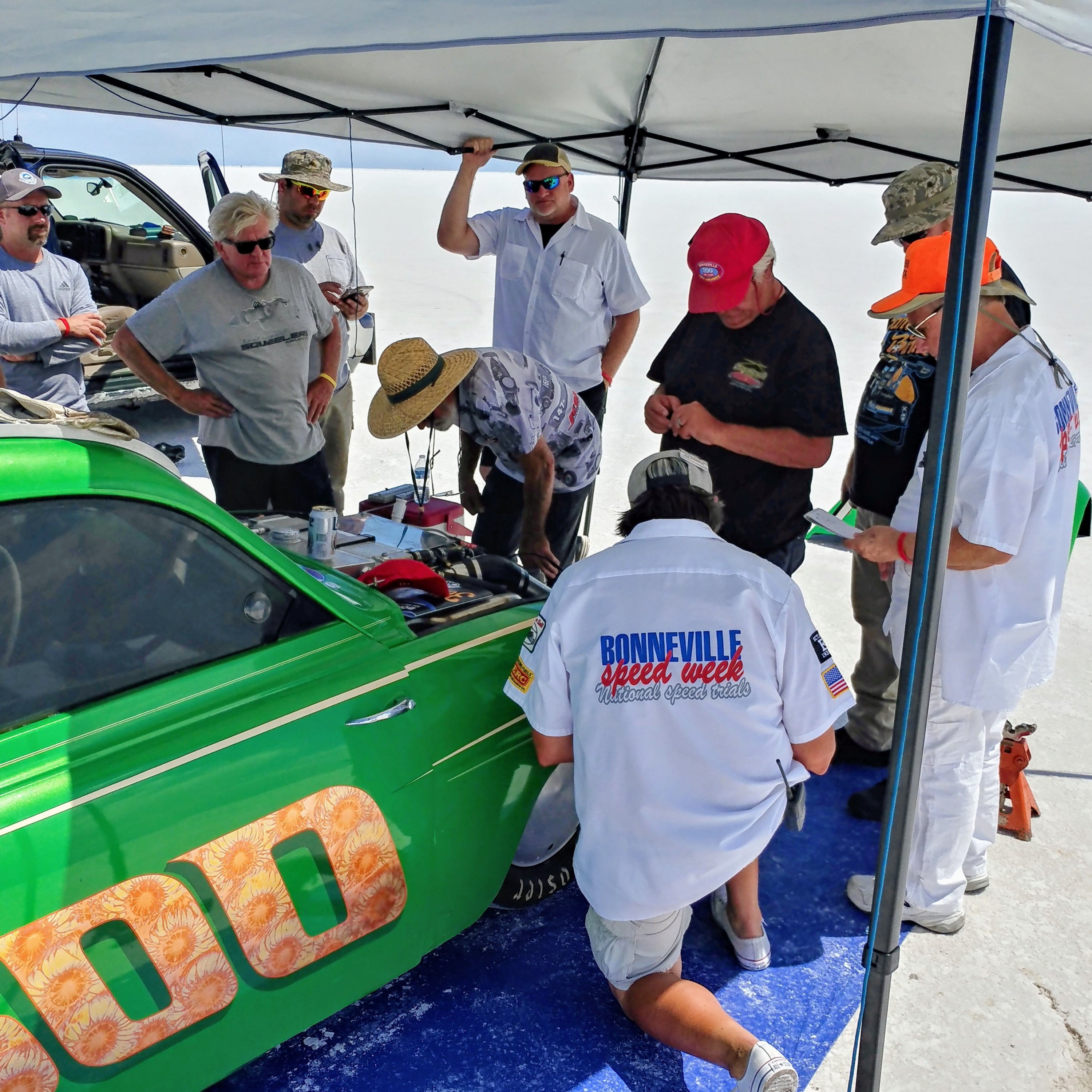
Driver’s reaction after the final run… turn up the volume.
Disqualification
We’re not the first to make this mistake, we’re told. The information packet handed out at registration makes the proper procedure clear; but none of our six people read it. At least two of us should simply know this, from experience; but in the excitement it did not come to mind. Sadly, a different team also violated a rule on Friday morning, and were also disqualified and had to run again. Their engine blew up in the qualifying attempt.
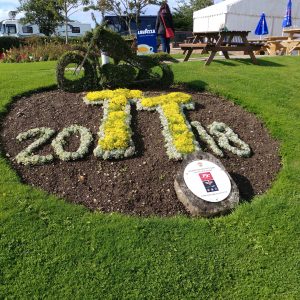 I went to the Isle Of Man to watch some motorcycle races.
These were not the (in)famous ‘Tourist Trophy’ (TT) races; those were held earlier this year, as they’ve been ‘most every year since 1907. The IOM TT races are contested by the best young & fearless talent, on the latest & fastest two-wheeled machinery. The IOM TT is billed variously as ‘The World’s Ultimate Road Race’ (by the promoters) and as ‘one of the most dangerous racing events in the world’ (by knowledgable observers). A few moments spent on youTube can demonstrate the IOM TT’s essential character: ludicrous speed on narrow roads lined with trees and stone walls. Full-course average speeds are around 135mph.
I went to the Isle Of Man to watch some motorcycle races.
These were not the (in)famous ‘Tourist Trophy’ (TT) races; those were held earlier this year, as they’ve been ‘most every year since 1907. The IOM TT races are contested by the best young & fearless talent, on the latest & fastest two-wheeled machinery. The IOM TT is billed variously as ‘The World’s Ultimate Road Race’ (by the promoters) and as ‘one of the most dangerous racing events in the world’ (by knowledgable observers). A few moments spent on youTube can demonstrate the IOM TT’s essential character: ludicrous speed on narrow roads lined with trees and stone walls. Full-course average speeds are around 135mph.
The TT is iconic, but for me as a spectator, kind of one-dimensional. The motorcycles all look and sound and perform alike. You’ve got to check the number as it goes by to know one from another. I don’t have a favorite rider to cheer for, and I lack the long term association with the race that would make me keen to follow the tiny differences.
The other races held on the island, the ones I attended, were the Manx Grand Prix and the Classic TT. The first of these is essentially a qualifier for riders hoping to graduate to the TT; bikes are somewhat smaller and somewhat slower, and the competition is a bit — just a bit — looser. That makes for a funner pit – riders and mechanics may occasionally smile and joke, which I doubt you see at the TT. And the second of the races is a distinct animal altogether.
The ‘Classic TT’ is populated with older bikes. The motorcycles were manufactured as old as the 1950s and as new as the 1980s. There’s a tremendous variety of sounds, sights, styles — a veritable cornucopia of mechanical expression. The set as a whole describes the evolution of racing motorcycles, with the path of improvement laid out in physical examples rather than pictures or text. And not ‘as seen in museums’, though many examples are collection-quality; these are here to race.
They’re sometimes piloted by modern stars, but more often by vintage riders who won various TT classes back in the day. From my experience, neither the older technology nor the sometimes older riders lead to a lessening of commitment. The fastest of the Classic TT are circling the course at around 120mph average.
The ‘TT course’ is a linking of four main roads on the island. The A2, southbound through downtown Douglas; west on the A1 to Ballacraine Corner; the A3 to Kirkmichael and north to Ramsey; and then the A18 up across Snaefell Mountain back to Douglas. It’s 37.75 miles in length. During practice, or the races, officials close all of it to other traffic. Practices are 2-to-3 laps; races are 2-to-4 laps. That makes the Classic TT Final about eighty minutes long. It’s hard for me to imagine the level of focus and concentration that’d take.
I went to IOM with two long-time motorcycling partners: Scary Don Siewert, and my younger brother Anton. 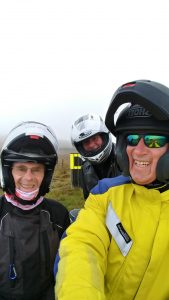 I’ve ridden with both of these guys for decades. They’re not stodgy, but they’re not psycho. Well, Don used to be psycho, but he’s mellowed. I trust ’em. On Friday, Saturday, and Monday mornings, before breakfast, the three of us made a lap of the TT course. Each time we climbed the summit of the mountain portion, treacherous gusty winds pushed us around on the road. There were painted stripes (slippery!) and iron drain grates (disturbing!) throughout. The off-camber shaded twisties near Glen Helen always seemed moist. So many blind corners… we all knew IOM’s reputation, and these circuits did nothing but cement that reputation in our minds. We were running at, or somewhat above, the speed limit, as the roads weren’t closed, and it took us 58 minutes to make the round. The Classic TT racers were doing it in ~22 minutes.
I’ve ridden with both of these guys for decades. They’re not stodgy, but they’re not psycho. Well, Don used to be psycho, but he’s mellowed. I trust ’em. On Friday, Saturday, and Monday mornings, before breakfast, the three of us made a lap of the TT course. Each time we climbed the summit of the mountain portion, treacherous gusty winds pushed us around on the road. There were painted stripes (slippery!) and iron drain grates (disturbing!) throughout. The off-camber shaded twisties near Glen Helen always seemed moist. So many blind corners… we all knew IOM’s reputation, and these circuits did nothing but cement that reputation in our minds. We were running at, or somewhat above, the speed limit, as the roads weren’t closed, and it took us 58 minutes to make the round. The Classic TT racers were doing it in ~22 minutes.
The course was fascinating, the whole island scenic, and the practices and races entertaining; but the high points for us came from the stupefying range of motorcycles there. Some that none of us had ever seen, and some in great profusion in the amusing presence of so.many.clubs dedicated to such-and-such odd model. There were twelve riders from Sweden who’d come over on their BSA A65s (none newer than 1966). There were the similarly Scandinavian fans of Kawasaki W650s and W800s, motorcycles rare in the U.S.A. but quite a cult classic elsewhere, judging from the hordes of ’em swarming the paddock – each bike customized to suit the owner’s individual preferences. The Ducatis travelled in packs, we saw clutches of older grey-haired couples running about on tiny minibikes like cheerful Hells Angels, the Triumph Bonnevilles were strewn about four to each corner. PLUS the Benellis and Guzzis and holy shit a Harris-framed GS1000, there’s a knot of Greeves, every kind of motor wedged into Norton frames, with tank badges hinting at the type of hybrid: Harton for a sportster engine; VInton for a BlackShadow mill; a big Yamaha V-Twin with the engine case ident polished off in another.
There were sidecars 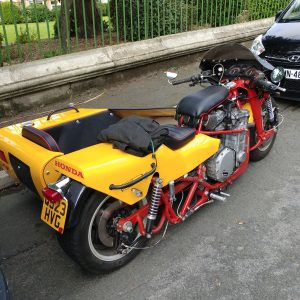 and race bikes and a chopper, I think. There were roving bands of dual-sport riders ‘scrambling’; there were all the latest fastest hyperbikes with their intense owners. There were older two-strokes so heavily customized and updated that only the core of the original remained.
and race bikes and a chopper, I think. There were roving bands of dual-sport riders ‘scrambling’; there were all the latest fastest hyperbikes with their intense owners. There were older two-strokes so heavily customized and updated that only the core of the original remained. 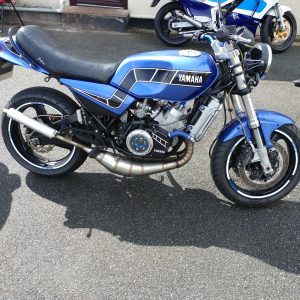 And this whole soup of two-wheelers was in constant motion about the island, heading to the museums, working up the back roads to reach a viewing spot on the course, filling the restaurants and inns, every parking lot an impromptu motorcycle show, most every conversation one about the elegant mode of motion which depends on balance and grace, and the crafted mechanisms that enable it.
And this whole soup of two-wheelers was in constant motion about the island, heading to the museums, working up the back roads to reach a viewing spot on the course, filling the restaurants and inns, every parking lot an impromptu motorcycle show, most every conversation one about the elegant mode of motion which depends on balance and grace, and the crafted mechanisms that enable it.
There are precious few ‘appliance’ motorcycles. The notion of vehicles-of-anonymous-utility does not mesh well with the gentle art of cycling; what would be the point? Motorcycles move you in both the physical world and in the inner sanctum. We were moved. And then we came home.
I must say that, sadly, not all of the racers did come home. Even at the Manx GP and Classic TT, the stakes are high, and the penalty for failure is severe.
Or “The Mountain Course”, is a 37.75 mile clockwise loop through four towns, six or ten villages, half-a-dozen roundabouts (taken straight), and a windy wild climb up – and down – a soaring road over the spine of the island.
For the racers, every straight of any length is a chance to gain a slice of a second. If you’re not, the others will. Speeds around the whole are running near 120mph average.
We ran it this morning, before breakfast for a clearer route, and I’d forgotten the first mile by Union Mills.
Has weather like Portland. In the Fall.